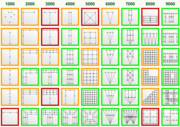Pear
Next to grapevine, pear is probably the best-known espalier fruit. Undemanding pear varieties can be espaliered (on sunny walls) in climates where pears wouldn't otherwise thrive, like in high altitudes and colder climates. In milder climates where fruit-growing or even viticulture is practised, you can grow (via walls) pears of excellent quality that would not be available commercially because of the difficulty of storage and transport. If 'winter pears' are chosen to espalier, a cool, damp storage area must also be available for ripening...
Latin: pyrus communis

How to thrive... Where to find...
Pear needs deep, warm soils and walls facing south or west. In the presence of juniper trees (usually the ornamental variety, like in residential urban areas), there is a risk of pear trellis rust. Pear rust is a fungus that uses the juniper as an intermediate host. It limits the assimilation capacity of the affected leaves; while it does not directly afflict the fruit, it is aesthetically speaking, a deathblow for a trellised pear. Already pruned pear espalier trees are available at local nurseries or by mail order online.
Characteristics and Pruning
When cultivated on an espalier, pear is treated as a shapeable tree (all espaliered fruit is classified as such). Pears are not self-fertilising, so it is important to have fertile varieties that flower simultaneously and within 200 metres. The presence of simultaneously-flowering pollinator varieties in the neighborhood (at least within 200 meters) is therefore important. Look online to find which cultivars are suitable as pollinators ("pollen dispensers") for a given pear cultivar. This is especially important outside of arboriculture areas. Consider also the different flowering times of various cultivars: a fruit tree espaliered on a facade or wall will flower sooner than a tree planted in the 'open.' To reduce the risk of incompatibility, it is best to plant several different types.
Pruning is also carried out on a cultivar-specific basis. Information is relatively accessible ~ available in specialized guides or online, and describes very precisely where the cultivar will bear fruit and how it must be pruned. When purchasing a tree, care must be taken that it has been grafted correctly and that it is specifically sold as an espalier tree. Some tree nurseries even provide trees with a double graft so that fertilisation is assured (that is, that allow the flowers of the same plant to pollinate each other).
Climbing Supports on the Facade
See the table below for all suitable trellis shapes (wire rope systems). For an optimal distance between the tree and the facade, choose a trellis in our heavy or massive range; a system in the middle or easy ranges is also possible. Pear espalier trees can be grown on a wooden trellis. For planted in a row (so, free-standing), use a 0050 trellis.
Pear trees can easily be pruned into various shapes with the support of climbing aids~ either in several horizontal tiers, in a vertical U shape, or in angled palmettes. To make maintenance and training easier, there was a trend starting around 1950 to move away from strict palmette shapes to more free-form natural fan shapes. For the last two decades, however, nurseries have been providing pruned and formed trees at affordable prices, which has led to a revival of the stricter (traditional) espalier shapes. The axes of the cable system must then be adapted to that of the pre-trained tree. Free (fan) shapes require simpler trellises.
Pear needs a support, as described on the general page for espaliered fruit trees, with about 35-40 cm between the main axes. With square-meshed cable systems, you may have to modify the arrangement of the axes accordingly during assembly.
Suitable cable systems for pears
Please click on the graphics to call up the detailed view of the respective system!
| = suitable | = conditionally suitable | = not suitable |


























































































